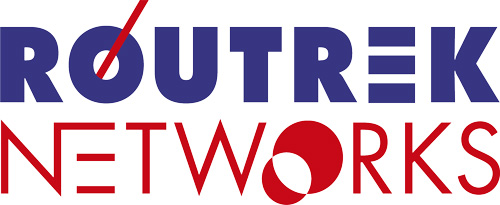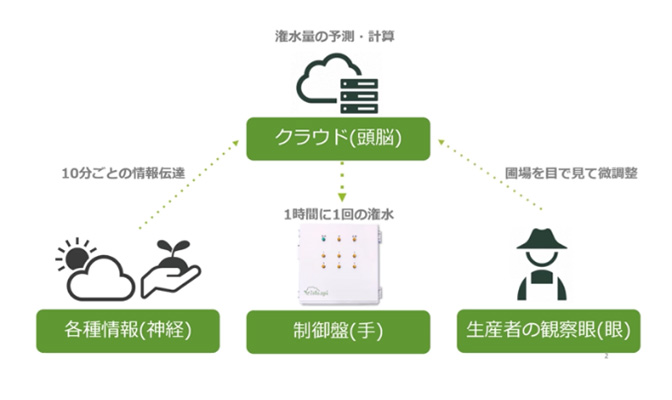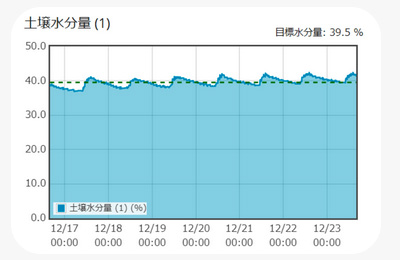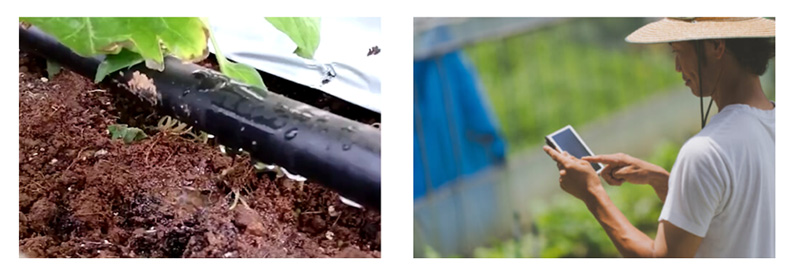Notes
(*1) Soil moisture is considered the most important factor that has a significant impact on growing yields. If a crop is not well watered during the growing season, its growth will be suppressed and yield will decrease. On the other hand, there is an aspect of proper irrigation that requires many years of experience and intuition based on that experience.
Automation With AI and IoT for Optimal Irrigation and Fertilization for Both Crops and the Environment
Routrek Networks, Inc.
| Publication date | June 21, 2023 (Posted on May 20, 2024) |
|---|---|
| Sector | Agriculture, Forestry, Fisheries / Water Environment and Water Resources |
Company Overview

Based on the M2M/IoT technology cultivated since its establishment in 2005, Routrek Networks, Inc. entered the smart agriculture business through joint research with Meiji University's Kurokawa Farm in 2010, which was triggered by the "Project for Establishing Food Safety and Security Using ICT," a wide-area collaboration project by the Ministry of Internal Affairs and Communications. The company received the 4th Japan Venture Award (Agricultural Venture Award, Minister of Agriculture, Forestry and Fisheries Award) in 2018, and was selected as a J-Startup Company by the Ministry of Economy, Trade and Industry, and as an Advanced Technology Project "Innovation Japan" by the Cabinet Office, Government of Japan in the same year.
Climate Change Impacts
Droughts caused by climate change are expected to occur with increasing frequency and intensity, which could affect stable water supplies. As a solution to the food supply and demand problem, large amounts of water and fertilizers are needed to improve the productivity of agricultural products. Groundwater pollution and CO2 emissions from chemical fertilizers are also issues, and the Ministry of Agriculture, Forestry, and Fisheries (MAFF) has stated in Strategy for Sustainable Food Systems, MIDORI that it will reduce the use of chemical fertilizers by 20% by 2030.
In the future, sustainable agriculture will be required maintaining high productivity with appropriate amounts of water and fertilizers without waste.
Adaptation Initiatives
In collaboration with Meiji University, we developed "ZeRo.agri," an AI irrigation and fertilization control system that automatically performs watering (irrigation) and fertilization. This system can be introduced into pipe-frame greenhouse horticulture. "ZeRo.agri" has the following functions (Fig. 1).
- Transmission of soil moisture content information acquired by sensors in the soil to the cloud (*1, Fig. 2)
- Based on the accumulated sensor data and solar radiation forecast, AI estimates the amount of transpiration from crops per day and calculates the optimal amount and concentration of liquid fertilizer to be supplied.
- The optimal amount of irrigation and fertilization is applied through drip tubes.
- Farmers can check soil conditions, irrigation/fertilizer application amounts, estimated CO2 emissions, and system operation status with a smartphone or other device (Fig. 3).
- Target values for automatic control can be set based on the producer's own experience.
Conventional irrigation involves supplying a large amount of water at once with a manual valve, which places a great deal of stress on the crop. By utilizing "ZeRo.agri," the following two advantages can be obtained.
- Stable control of soil moisture content reduces stress on crops, leading to improved yield and quality.
- Enables High-precision management that is difficult to achieve manually, and minimizes the amount of water and fertilizer used.
Since its launch in 2013, a cumulative total of more than 360 units of this "ZeRo.agri" system have been installed nationwide.
Effects / Expected Benefits
“ZeRo.agri" uses AI to manage the amount of irrigation and fertilization based on accumulated data, enabling stable growth of high-quality crops even with limited experience. Furthermore, automation and remote management can reduce the burden on growers by reducing the risk of heat stroke in the summer and shortening labor hours. Such reduced burden and increased productivity could lead to a solution to the shortage of farmers. In addition, from an environmental standpoint, the system not only saves water, but also reduces chemical fertilizers through precise control of fertilizer application, prevents groundwater pollution by nitrate-nitrogen, and contributes to carbon neutrality by reducing CO2 emissions from the soil.


(Graphs can be viewed from a smartphone or computer.)


